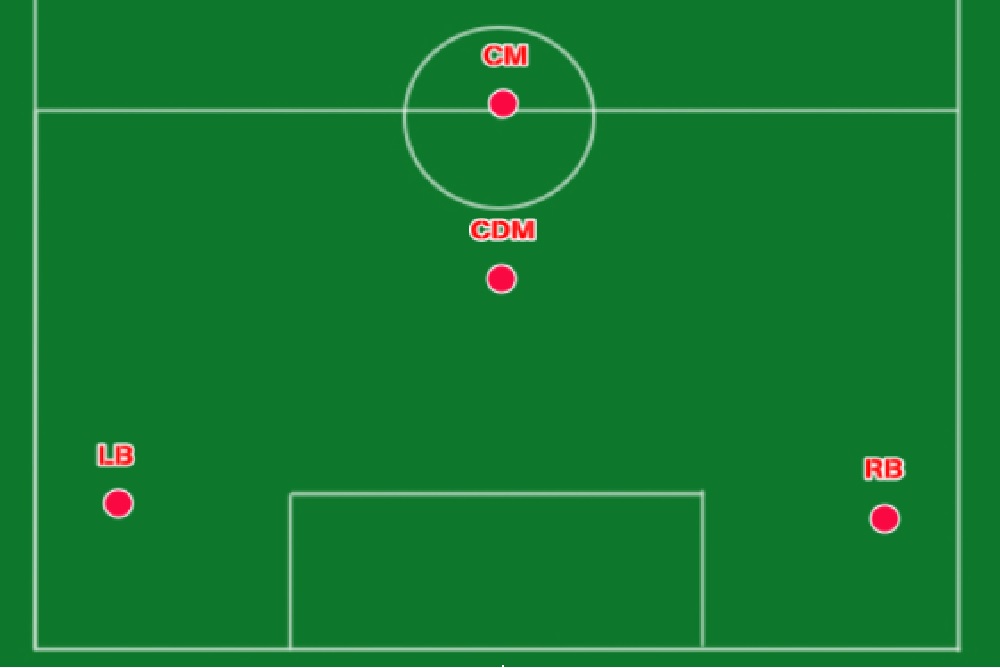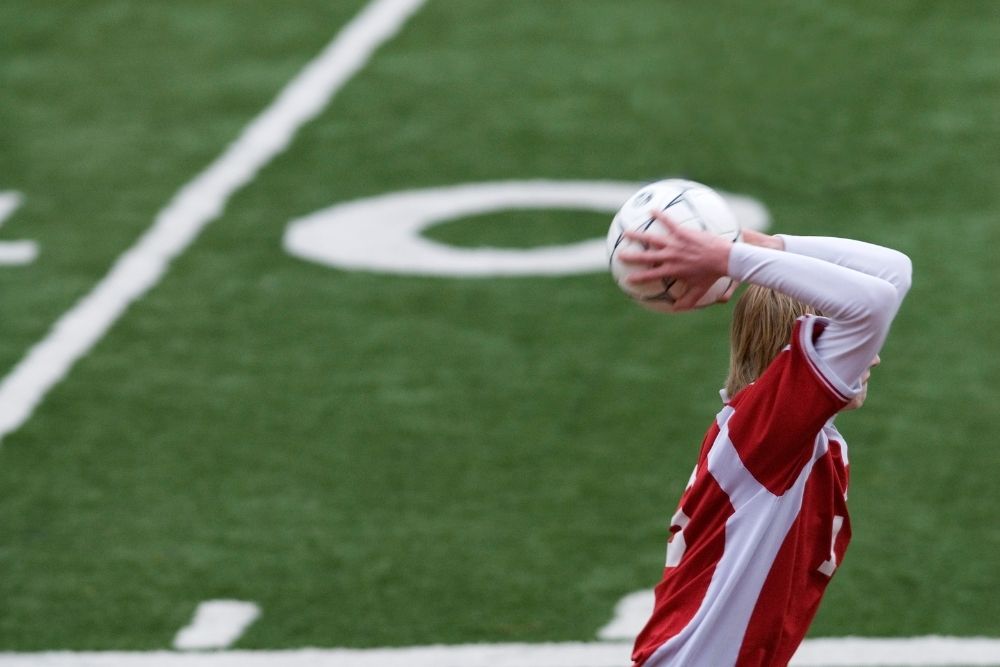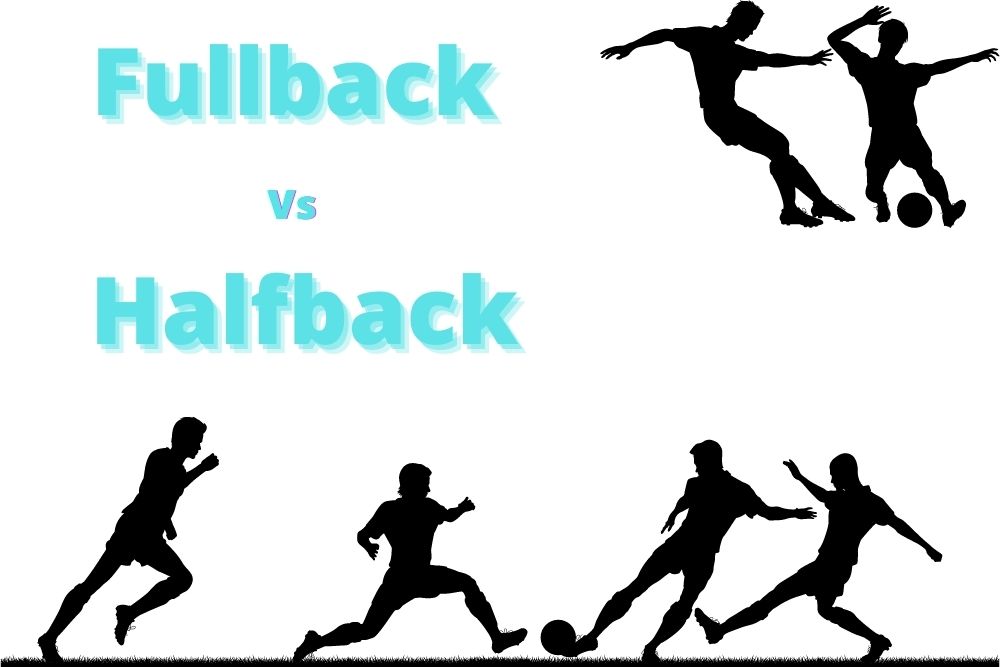Searching through the history of soccer, you will find great teams who have entertained and inspired the love shown to this game. And most of these teams found a balance between defense and attack.
This duty of being a point of balance for a soccer team weighs heavily on two significant field portions. These are the midfield (also known as the Halfback position) and the defense (two center-backs and two fullbacks).
These separate units play an essential role in ensuring a team comes out on top. Generally, halfbacks shield the goal, and the keeper, the left and right fullbacks help protect the wings, block crosses and occasionally support the attack.
Moreover, this article hopes to explore these two positions. Examining their roles, similarities, differences, and importance to general gameplay and the all-round evolution of the game.

Quick Navigation
What is A Soccer Fullback?
You can refer to fullbacks as an integral part of the defensive unit. They are positioned either on the right or the left side of the flanks. And the role of a fullback is filled with making a lot of runs across both ends of the pitch.
As a result, speed and endurance are key attributes necessary for playing in these roles. Nevertheless, what are their roles?
Role of a soccer fullback
Defending against opposing attacker
Fullbacks obstruct attackers of opposing teams by manning their positions and forcing the attackers to play on their weaker sides. This is possible because a significantly larger number of players are one-footed.
Blocking a player from moving the ball with the stronger foot will lead to the player cutting in towards a defensive halfback or the center-back. This ultimately results in a loss of possession, except the attacker out-maneuvers the fullback or wins a corner-kick.
Taking Throw-ins
Due to their closeness to the touchline, the task of taking throw-ins is usually given to fullbacks. They receive the ball back in most cases and initiate attacks in partnership with other attackers. Plus, maintenance of defensive lines and general tactical discipline
The offside rule in soccer comes into play when a player is in the opposition’s half and nearer to the opponent’s goal than the last opponent and the ball when the ball is passed to the player from a teammate.
Most attackers seek to exploit this rule by staying close to the fullback or center-back, hoping to beat the defenders with speed and strength when the ball is passed.
Many attackers, like Retired Filippo Inzaghi, mastered this skill to devastating effects; hence fullbacks ought to beware. The best fullbacks stay switched on and mentally alert all through the ninety minutes of the game to spring offside traps against lurking attackers.

Creation of flanks sided passing options
Different teams employ different tactics in a soccer match, filling portions of the field, hoping to outclass their opponents. Unfortunately, this formation usually has one or two weaknesses that could be exploited.
For formations that favor having men on the sides of the pitch than on the wings, the room for flank side passes may be available. This allows link-up play between halfbacks, fullbacks, and attackers.
Creating spaces and drawing opposition teams
Fullbacks occasionally join the attack when their team is with the ball. They can draw the opposition out of position to create spaces behind that could be maximized for a goal-scoring opportunity.
Types of soccer fullbacks
Traditional fullbacks
The traditional fullbacks are the defenders occupying the flanks and playing on the side with their stronger foot. This implies that right-footed players playing on the right-hand side of the defensive flank are referred to as right-backs.
At the same time, a left-footed defender on the left side is referred to as a left-back. And their primary duty is to defend the flanks against wingers, crosses, and other attackers.
Inverted fullbacks
The inverted fullback is a variation of the natural fallback position in which the fullback plays in the position opposite to the player’s naturally stronger foot. This means that a right-footed fullback will play on the left-hand side while the left-footed fullback plays on the right-hand side.
In the defensive phase, the inverted fullback operates like a traditional fullback protecting the lateral ends of the field They track down wingers of opposing teams, and shield the center-backs.
While in the attacking phase, the inverted fullback takes up position alongside the team’s defensive midfielders. This allows the midfielders to move further upfield to support the attack.
The inverted fullback method has proven effective for most modern teams, especially when facing the wingers who like to cut in during the defensive phase. However, the inverted fullback position is not without its flaws.
Soccer players in this position are thoroughly exposed when they come up against wingers who are good on both feet. They also struggle when facing natural wingers who prefer to move on the bylines and whip in crosses.
This is because in cases where the inverted fullbacks have to defend with their weaker feet, it exposes them. An example of a team that uses the inverted fullback initiative is Manchester City.
What is A Halfback in Soccer?
Halfbacks (also called midfielders) are players positioned at the midway area of the soccer pitch, right between attackers and defenders. They help maintain possession of the ball, making interceptions to retrieve the ball from the opposition when necessary.
Generally, there are usually more than one halfback in a starting eleven, and they play different roles. So, for example, you would have one center halfback tasked with breaking up opposition play and another two responsible for ball distribution to attackers and defenders in some cases.
Halfbacks are expected to cover many areas of the pitch, performing attacking and defending duties. These duties depend on the role they play in the middle of the park. And some of these roles include:
Role of halfbacks in soccer
Attacking halfback
With strikers standing as the focal point of the team, the attacking halfbacks serve as the pivot of the offensive line. They are positioned between the center midfield and the forwards.
They are sometimes given the Number Ten shirt as the playmaker of the team. Plus, the attacking halfbacks tend to orchestrate the game’s flow, creating goal-scoring opportunities through precision passing and all-round awareness.
Generally, it is required of soccer players manning these positions to possess excellent technical quality as they are usually heavily marked. In addition, they are expected to be agile, quick, able to think fast, and make defense splitting passes.
Some of the greatest soccer players like Zinedine Zidane, Michel Platini, Luis Figo, and Ronaldinho are perfect examples. They mounted this position and wowed the world with their deft touch, superior dribbling skills, and acute vision.
Center halfback
Center halfbacks serve as a bridge linking the attack and defense. Positioned at the middle of the pitch, they shield the defense and help the team win ball retention and retrieval.
They also support the team when attacking by making runs into the opposition’s eighteen-yard box. In some cases, they are known to initiate attacks and perform playmaking duties.
Due to their unique vantage point, they can view most of them taking place on the field. This allows them to pick out passes and dictate the flow of the game.
The passing ability is crucial for this position, and the best examples of players who have been terrific in this role are all excellent passers of the ball.
Players like Andrea Pirlo, Cesc Fabregas, Luka Modric, Steven Gerrard, Frank Lampard, and Kevin De Bruyne are all perfect examples in the execution of this role.
Defensive halfback
The defensive halfback (also known as the defensive, holding midfielder) is a center halfback stationed right in front of defenders. They serve as an additional protective cover, shielding the defense when the rest of the midfield is in an attacking phase of play.
They screen the defense by pestering opposition team players, hopefully winning the ball in the process and distributing it to other teammates. This makes their role to be primarily defensive.
The execution of the defensive halfback role usually requires players that possess excellent tackling ability, positional awareness, high work rate, strength, and stamina.
Deep-lying playmaker
The game’s evolution has brought into prominence the defensive halfback position, and a fusion between the role and that of a center halfback birthed the deep-lying playmaker role.
These are defensive halfbacks charged with the additional responsibility of dictating the game’s tempo by playing long passes from a deep position. They have the close control ability to play under immense pressure and pick out passes to other outfield players.
Wide halfbacks
The Wide halfback is a soccer player positioned at the left or right center portion of the midfield. Their duties are more similar to that of a wingback than a natural winger. Supporting the attack from the wings and providing extra cover for the defense are core in the duties of a wide halfback.
Box-to-box halfbacks
These are center midfielders who have a lot to offer both defensively and offensively. As their name implies, they are strong, mobile, and can be seen moving from one end of the pitch to the other for the duration of a ninety-minute match.
They are known to track down a defensive box, making tackles, blocking shots, and being a complete nuisance to the opposing teams. The box-to-box halfbacks are also able to carry the ball forward at great speed to support the attack.
Deployed majorly in the 4-3-3 and the 4-2-3-1 formations, they are relentless and a joy to watch. Box-to-box halfbacks worthy of note include Yaya Toure, Patrick Viera, Blaise Matuidi, Roy Keane, and Jordan Henderson.
Soccer Fullback Vs Halfback
The soccer fullback and halfback positions are essential, playing vital roles in team form and structure. Each position has its uniqueness and demands. However, versatile players have been seen over time switching between these roles and executing both to perfection.
An example is English Man James Milner who in his younger years played on the wings. Then later, he played in the halfback and the fullback positions as he grew older. Listed below are several attributes of both positions.
Attributes | Fullback | Halfback |
Skill | Long cross, wing defense, and minimal technique is required | Short and long crosses, center defense, and requires a measurable amount of technique to move in tight spaces. |
Physical Condition | Lightweight, pacey, with a lot of stamina and endurance | Less emphasis on speed and more on ball control, passing, and ball retention ability |
Playing style | They focus more on the defensive side of the game and venture forward occasionally to support the attack. | Depending on midfield position, the emphasis shifts between attack, defense, and both. |
Formation | They are utilized in 4-Men or 5-Men defensive formations | They are a crucial part of every formation in soccer. |
Position | They are positioned on the left or right hands of the defensive third. | They are positioned at the midway area of the soccer pitch(except for attacking halfbacks who move a bit forward beyond the center circle) |
Movement | They often move in straight lines from one end of the pitch to the other maintaining their paths along with the wings | Heatmaps have shown that halfbacks occupy the highest kilometers in soccer matches. Hence they move frequently along all sides of the pitch. |
Transition | Full-backs usually transition from this position to become center-backs, wingback | Halfbacks are blessed with longevity and rarely leave their positions even as they grow older |
Injury Susceptibility | Less prone to injury when compared to other outfield players | More prone to injuries when compared with fullbacks and defenders |
Strength | Speed, Crossing ability, Stamina, optimum attacking qualities, and endurance. | Vision, technique, stamina, crossing ability, Shooting ability, and great attacking qualities. |
Weakness | Limited and not useful in other positions across the field | They are usually lacking speed when compared to full-backs. |
Types of Cleats | Good ball feeling, lightweight, and speed support. | Ball control, slightly heavy, good passing accuracy |
Importance of Fullbacks and Halfbacks
Fullbacks
- Creating Scoring Chances
Crosses from the flanks have resulted in goals numerous times. Most teams play with a big center-forward capable of latching on to crosses from either side of the flanks. Fullbacks help create these types of changes when they make forward runs to support the attack.
- Impeding wingers and blocking crosses
One of the key duties of a fullback is to prevent the winger from cutting in or making crosses from the byline. Wingers and attackers generally have a knack for utilizing weakness on the side of a fullback to devastating effect. This is why fullbacks must be decisive when making tackles.
- Supporting the midfield
Inverted fullbacks create a different dimension when they cut into the midfield from their original position. This, as a result, improves the number of their players in the opposition half.
Halfbacks
- Assist in attack and defense
Halfbacks play the dual role of supporting both the attack and the defense. Therefore, the ability to link up play between both halves of the field is crucial to any winning team.
- Ball retention
Another key feature of the halfback is holding up play. This is done to allow the team to find its rhythm in a soccer match. The longer the team holds on to the ball, the easier it is for them to find the back of the opposition’s net.
This is also crucial when a team is trying to see out a game and wants to limit the chances of losing possession in the dying embers of a match.
- Accurate passes
There are times in matches where spaces are tight. Teams find it to move the ball in these situations. In most instances, they rely on the midfielders to find the right passes and movement sequences.
This is why in most games, the ball is returned to the midfield, and the halfbacks move the ball around until a gap is found in the opposing team’s defensive setup.
When playing against high-intensity teams, the skill of the halfback is of great importance. It allows them to wade through the pressure and find a pass calmly.
- Effective leadership
Halfbacks and defenders have proven to be effective leaders on the pitch. Their vantage points help to recognize danger early enough for it to be averted.
They continue in this vein and turn out to be great coaches when their playing days are over. Examples of Halfbacks who became coaches are three-time Champions League-winning coach Carlo Ancelotti and legendary Spaniard Pep Guardiola.
Conclusion
All positions are essential for the proper functioning of a soccer team. However, several positions like the halfback play a more significant role in deciding the game’s fate.
This is why players in this position have many legends who have won the highly coveted Ballon D’or award. In essence, you can say fullbacks are essential and halfbacks are indispensable.
Hi there, I’m Jay.
Soccer is everything in my life! My friends and I have created this blog with all our enthusiasm, passion, and understanding after years of playing pro soccer. Hope you will enjoy it!
